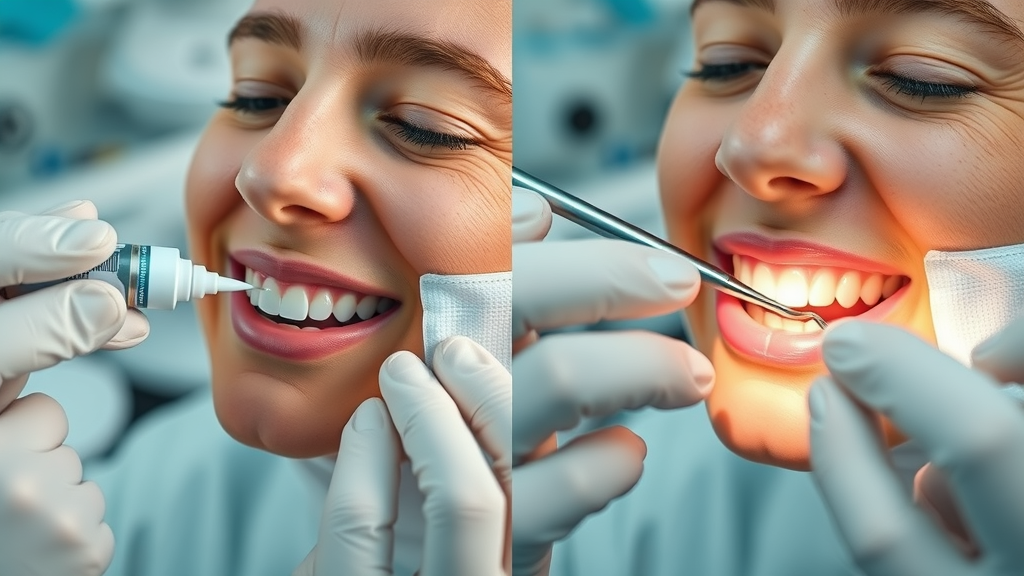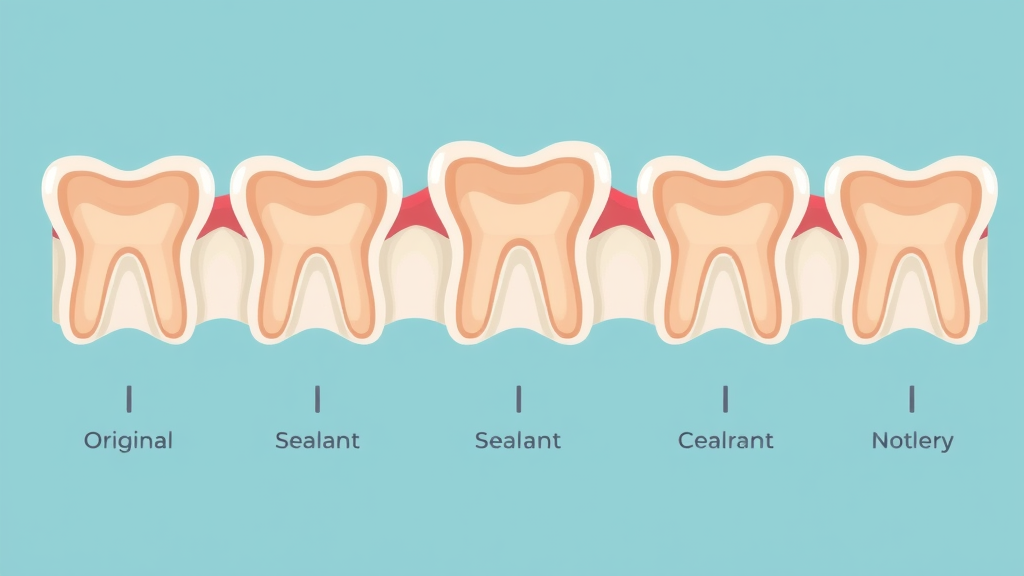Did you know that more than 40% of children develop cavities before they even reach kindergarten? This startling fact underlines the importance of taking preventive steps in oral care, including the use of dental sealants. In this guide, we'll reveal how sealants help protect smiles of all ages, clarify what sealants are, and walk you through their application and maintenance so you can make informed decisions about your dental health.

Understanding What Are Sealants: Protecting Smiles and Preventing Tooth Decay
-
What sealants are and how they work
-
Differences between sealants and fillings
-
How sealants prevent tooth decay
-
Benefits, risks, and maintenance tips
-
Answers to common sealant questions
Dental sealants are a cutting-edge preventive solution in modern dentistry, specifically designed to protect teeth from cavity-causing bacteria. So, what are sealants? Sealants are thin, protective coatings that a dentist paints onto the chewing surfaces of back teeth—primarily molars and premolars . These areas are often riddled with deep grooves and pits, making them more susceptible to trapping food particles and bacteria, and therefore, more prone to cavities. When applied, the sealant fills these grooves, creating a smooth surface that acts as a barrier, effectively blocking out bacteria and preventing tooth decay before it starts.
The aim of using sealants is not just to address problems after they've developed but to prevent issues from occurring in the first place. With statistics showing that nearly half of young children acquire cavities early on, sealants have become a crucial part of pediatric and preventive dental care. They are quick, noninvasive, and cost-effective compared to restorative solutions like fillings and can go a long way in ensuring a bright, healthy smile for years to come.
For families considering sealants for their children, it's helpful to understand how pediatric dental care supports long-term oral health. You can learn more about specialized approaches and preventive strategies by exploring our pediatric dentistry services , which focus on creating positive dental experiences and protecting young smiles from an early age.
Dental Sealant Overview: What Are Sealants and Why Are They Recommended?
Startling Statistic: Over 40% of children develop cavities before reaching kindergarten—discover how dental sealants can help prevent tooth decay.

What Are Sealants and How Do Dental Sealants Work?
Dental sealants are made from liquid plastic materials that are carefully painted onto the chewing surfaces of back teeth . Once the sealant is applied, it quickly hardens—often with the help of a blue curing light—forming a durable, invisible shield over the pits and fissures where food particles and bacteria tend to collect. Unlike fillings, which are used to repair teeth after decay has occurred, sealants are strictly preventive . This protective barrier reduces the risk of developing cavities by sealing out debris and blocking out acids produced by oral bacteria.
The process of applying sealants is simple and painless. Your dentist or dental hygienist first cleans and dries the tooth, applies a gentle etching solution to create a rough texture for better adherence, and then paints the sealant material onto the surface. This procedure is especially beneficial for children whose back teeth (permanent molars) have deep or hard-to-clean grooves. In just a few minutes, this solution can shield the tooth for several years, making it an effective and invaluable addition to your regular dental care routine.
Benefits of Dental Sealants for Back Teeth and Baby Teeth
The biggest advantage of dental sealants is their ability to dramatically reduce the risk of cavities, especially in those vulnerable molars and premolars. According to the American Dental Association, applying sealants on children’s back teeth can lower the risk of decay by nearly 80%. This is particularly important for baby teeth, which act as placeholders for permanent teeth and guide their proper development and alignment. Protecting baby teeth with sealants helps maintain optimal oral health and reduces the need for fillings or more invasive dental work in the future.
Sealants are not exclusive to children. Adults who have deep grooves in their back teeth or a high risk of developing tooth decay can also benefit from dental sealants. The application is quick and cost-effective, often covered by dental insurance, and offers several years of protection with minimal follow-up. Plus, maintaining teeth with sealants is as easy as regular brushing, flossing, and dental checkups.
"Dental sealants are a game-changer for children's dental health, reducing the risk of cavities on back teeth by nearly 80%." – American Dental Association
Types of Sealants: Understanding Dental Sealants for All Ages
Sealants for Baby Teeth vs. Dental Sealants for Permanent Back Teeth

Sealants are customized to address the specific needs of both children and adults. Sealants for baby teeth are essential because these primary teeth often feature deep, narrow grooves. Since baby teeth help guide the eruption and alignment of permanent teeth, protecting them with sealants reduces the risk of early loss due to decay. On the other hand, dental sealants for permanent molars take on a long-term preventive role once these adult teeth come in—usually around ages 6 and 12. The treatment approach remains the same, but the goal is extended protection during the most cavity-prone years of life.
Essentially, the criteria for applying sealants involve assessing the shape and depth of tooth grooves, oral hygiene habits, and individual risk factors for developing cavities. Your dentist or hygienist will determine which teeth benefit most from dental sealants. Early and age-appropriate application ensures the best defense against cavity formation in both baby teeth and permanent back teeth.
Common Materials Used in Dental Sealants
The two most common materials used in creating dental sealants are resin-based sealants and glass ionomer sealants . Resin-based sealants are the most widely used and are prized for their durability and resistance to wear. Glass ionomer sealants are slightly less durable but release fluoride, which can provide added cavity protection. Both types are safe, effective, and specifically designed to bond with enamel while withstanding the forces of daily chewing. Your dentist will select the best material based on your unique needs, helping ensure long-lasting and reliable cavity prevention.
Both types of sealants form a thin yet powerful shield over the biting surface. The difference lies in longevity and additional benefits such as fluoride release. Talk to your dentist about which material is best suited for your individual circumstances or your child’s oral health requirements.
|
|
|
Comparison of Sealant Types: Resin-Based vs. Glass Ionomer Dental Sealants |
|
Feature |
Resin-Based Sealants |
Glass Ionomer Sealants |
|---|---|---|
|
Durability |
Highly durable; lasts up to 10 years |
Moderate durability; lasts 2-5 years |
|
Fluoride Release |
Does not release fluoride |
Releases fluoride for added protection |
|
Application |
Requires dry tooth surface; light-cured |
Can be placed in moist environment; self-cured |
|
Best for |
Children and adults with low decay risk |
Children prone to cavities; areas hard to dry |
How Dental Sealants Prevent Tooth Decay and Protect Oral Health
The Protective Barrier: How Dental Sealants Prevent Tooth Decay on Back Teeth
The main function of a dental sealant is to act as a thin yet durable shield over the chewing surface of teeth. By sealing off pits and grooves, sealants eliminate the hiding spots for food particles and bacteria that contribute to tooth decay . This barrier reduces the likelihood of cavities forming in areas most susceptible to harm—particularly the back teeth , which are hardest to reach with regular brushing.
This protective coating is especially crucial for children, as their oral hygiene habits may not be fully developed. Adults with naturally deep grooves, frequent snacking habits, or a history of cavities can benefit from dental sealants as well. With well-applied sealants , the path for bacteria to penetrate tooth enamel is effectively blocked, making it easier to maintain optimal oral health.
Sealants Versus Other Preventive Dental Measures
While brushing, flossing, and regular dental check-ups are irreplaceable, dental sealants add an extra layer of protection for the chewing surfaces where most cavities start. Compared to fluoride treatments or even fillings, sealants provide a direct, physical blockade preventing plaque buildup in vulnerable areas. They don’t replace good oral hygiene, but when used together with daily brushing and flossing and regular cleanings, sealants amplify the overall defense against tooth decay.
Besides offering a unique kind of protection, sealants are cost-effective and non-invasive. For children who have trouble reaching the nooks and crannies of their molars, sealants work alongside other preventive measures to make sure those teeth stay healthy until adulthood. Regular dental visits after sealant application ensure lasting results and the timely replacement of any worn sealant material.
-
Sealants can last for several years, sometimes up to a decade on back teeth
-
Highly effective in reducing risk of tooth decay
-
Routine maintenance: Regular dental check-ups and cleanings to examine and, if needed, reapply sealant
What to Expect: The Dental Sealant Application Process
Step-by-Step Guide to Applying Dental Sealants

Applying a dental sealant is quick, painless, and straightforward, making it an ideal preventive treatment for both children and adults. Here’s a step-by-step overview of what to expect during your visit:
-
Cleaning: The dentist or hygienist first thoroughly cleans and dries the tooth to remove plaque and debris from the chewing surface .
-
Preparation: An acid etching solution is applied to the surface for a few seconds. This process roughens the enamel slightly, allowing the sealant to adhere more effectively.
-
Rinsing and Drying: The tooth is rinsed and dried again to ensure a clean surface.
-
Sealant Application: The sealant material is painted onto the chewing surface of the tooth. The dentist may use a special light to harden the sealant quickly.
This simple and painless process takes just a few minutes per tooth. You can sit back and relax as your dental professional ensures every groove is safely sealed against future decay.
Pain, Safety, and What Patients Experience
One of the biggest benefits of dental sealants is that the procedure is completely non-invasive and pain-free . There are no needles, drilling, or discomfort—just a gentle cleaning and application. Patients typically feel nothing more than a slight sensation of coolness or wetness as the sealant material is brushed onto the teeth. Children in particular tolerate the application well, and many are surprised at how brief and easy the process is.
Dental sealants are safe for nearly everyone, including young children, teens, and adults. Allergic reactions are extremely rare, and modern sealant materials have gone through rigorous testing to ensure they are non-toxic and biocompatible. As with all dental procedures, your dentist will ask about known allergies or sensitivities before beginning. The end result is a strong, invisible coating that begins working immediately to reduce your risk of cavities.
Advantages and Downside: Weighing the Pros and Cons of Dental Sealants
-
Pros:
-
Effective in preventing tooth decay on back teeth
-
Suitable for children and adults
-
Quick, painless application process
-
-
Cons:
-
Not suitable for decayed teeth —only healthy teeth benefit
-
May require reapplication after a few years
-
Rare allergy risks (typically only for specific individuals)
-
"While dental sealants dramatically reduce dental caries, regular dental visits are crucial for ongoing protection." – Dr. Brian Walsh, DDS
Are Sealants the Same as Fillings? Clarifying the Difference Between Dental Sealant and Fillings
What Makes Dental Sealants Different from Fillings in Treating Tooth Decay

People often wonder about the difference between a dental sealant and a filling. The answer is straightforward: dental sealants are preventive, while fillings are restorative . Sealants are applied to healthy teeth, specifically targeting the grooves of back teeth before decay sets in. Their purpose is to prevent bacteria from causing damage. Fillings, on the other hand, are used after a cavity has formed. The dentist removes the decayed tooth material and fills the empty space with a restorative material to restore the tooth’s function and strength.
The chewing surfaces of molars and premolars are much more likely to benefit from dental sealants, especially when teeth have deep fissures. But once decay has already occurred, only a professionally placed filling can restore the tooth’s structure. That’s why sealants are often part of a comprehensive preventive care plan, minimizing the risk of ever needing fillings in the first place.
When to Choose Sealants vs. Fillings for Back Teeth
Sealants are the treatment of choice when teeth are healthy but at risk for decay , particularly in children and teens with new permanent molars . If your dentist finds grooves that are too difficult to clean with regular brushing but aren’t currently decayed, they’ll likely recommend a sealant. Fillings become necessary only after a cavity or tooth decay has already developed. The best way to avoid fillings is through early intervention with dental sealants, regular brushing and flossing, and professional checkups. Your dentist or hygienist can help determine which approach best fits your individual needs, age, and oral health history.
It’s important to remember that both sealants and fillings are effective, but their use depends on the condition of your teeth at the time of the dental visit. Sealants offer peace of mind and protection—think of them as an insurance policy for your smile, safeguarding the tooth before trouble starts.
Longevity and Care: How Long Do Dental Sealants Last on Teeth?
-
Average sealant durability on back teeth: 2 to 10 years, with periodic checks
-
Maintenance tips for longer-lasting results: Practice good brushing, avoid hard or sticky foods, and attend regular dental appointments
-
When to consult your dentist for replacement: If you notice chips, cracks, or feel that the sealant has worn down

On average, dental sealants protect teeth for up to 10 years, though many patients require small repairs or reapplications during this window. The exact lifespan depends on factors like chewing habits, diet, and how well you care for your teeth. Sealants may get worn down by chewing on hard objects, sticky foods, or habits like teeth grinding. Regular check-ups allow your dentist to monitor and repair the sealant before cavities can form underneath.
Good oral hygiene and avoiding damaging foods extend the life of your sealants. If you notice that your chewing surfaces feel different, or your sealant looks chipped or uneven, make an appointment to check for repairs or reapplication. Keeping up with dental visits ensures your dental sealant continues to offer maximum protection throughout its lifespan.
Ideal Candidates: Who Should Get Dental Sealants?
-
Children with erupting back teeth (molars and premolars)
-
Adults with deep grooves or pits in their molars
-
Patients of any age with a history or increased risk of cavity formation

Dental sealants are most commonly recommended for children and teens , typically soon after their permanent molars and premolars erupt—between ages 6 and 14. Early application provides the highest benefit, helping to prevent tooth decay during years when children are most at risk. However, adults without fillings or decay in their back teeth can also benefit from dental sealants, especially if they have deep chewing grooves or a history of cavities. Patients with limited dexterity, orthodontic appliances, or those who struggle with brushing and flossing may also be good candidates.
Talk to your dental care provider to determine if sealants are the right preventive measure for you or your child. Sealants are a proactive investment in a healthy, cavity-free future for people of all ages and backgrounds.
People Also Ask: Answering Top Questions About What Are Sealants
What is a dental sealant?
A dental sealant is a thin, protective coating painted on the chewing surfaces of back teeth . This barrier shields teeth from food particles and bacteria, helping prevent tooth decay. Sealants are especially valuable for children’s molars and premolars but can also benefit adults with deep grooves in their teeth.
What are the downsides of dental sealants?
The downsides of dental sealants are few but worth considering. Rarely, some people may experience mild allergic reactions to the sealant materials. Sealants are only effective on healthy teeth free from decay, and they can wear down over time—sometimes requiring reapplication. Regular dental check-ups will ensure that your sealants remain intact and protective.
Are sealants the same as fillings?
No, dental sealants and fillings serve different purposes. Sealants are preventive and applied to healthy teeth to ward off cavities, while fillings are used to repair teeth that have already suffered decay or cavities. Think of sealants as preemptive protection, and fillings as restorative repairs.
How long does a sealant last on teeth?
Sealants can last anywhere from 2 to 10 years. The duration depends on your oral hygiene, diet, and chewing habits. Regular dental check-ups help ensure sealants stay in good condition and are replaced or repaired as needed for continuous protection.
Frequently Asked Questions About What Are Sealants
-
Are dental sealants safe for children? Absolutely. Dental sealants are safe, non-toxic, and highly recommended for children once their molars emerge.
-
Do dental sealants taste or feel odd? Sealants do not have a strong taste or smell, and after they harden, they feel smooth and natural—no bulky feeling in the mouth.
-
Can adults benefit from dental sealants? Yes, adults with healthy, unfilled molars or a history of cavities can benefit from sealants just like children.
-
Are there any foods to avoid after getting sealants? While sealants are durable, it’s best to avoid chewing on sticky or hard foods (e.g., ice, hard candy) to prevent premature wear.
Taking the Next Step: Consultation, Application, and Long-Term Dental Care
-
Schedule a professional dental assessment
-
Ask your dentist about sealant suitability
-
Maintain regular dental hygiene to support sealant effectiveness
Explore Dental Sealant Solutions Near You
-
Johnstown Dental Care 370 West Coshocton St. Johnstown, OH 43031
-
Phone: (470) 967-6046 Website: www.johnstowndentalcare.com
-
Proudly Serving: Johnstown, New Albany, Granville, Alexandria, Pataskala, and surrounding areas in Licking County, Franklin County, and Delaware County
If you’re interested in taking a more comprehensive approach to your family’s oral health, consider how a trusted dental team can support every stage of your journey. From preventive sealants to routine checkups and advanced care, a family dentistry practice offers continuity, comfort, and expertise for patients of all ages. Discover how building a relationship with a dedicated dental provider can help you achieve lasting oral wellness and peace of mind for your entire household. Explore the full spectrum of services designed to keep your family’s smiles healthy, bright, and confident for years to come.
Take proactive steps: consult your dentist about sealants, maintain proper oral hygiene, and attend regular check-ups to protect your smile for years to come.
Dental sealants are thin, protective coatings applied to the chewing surfaces of back teeth—primarily molars and premolars—to prevent cavities. These teeth often have deep grooves that can trap food particles and bacteria, making them more susceptible to decay. By filling in these grooves, sealants create a smooth surface that acts as a barrier against harmful bacteria. ( cdc.gov )
The application process is quick and painless. A dental professional cleans and dries the tooth, applies an acidic gel to roughen the surface for better adhesion, rinses and dries the tooth again, and then paints the sealant material onto the tooth. A special light is often used to harden the sealant. Once applied, sealants can protect teeth from decay for several years, though they should be checked regularly during dental visits to ensure they remain intact. ( my.clevelandclinic.org )
Sealants are particularly beneficial for children and teenagers, as their newly erupted permanent molars are most at risk for cavities. Applying sealants to these teeth can prevent up to 80% of cavities over two years and continue to protect against 50% of cavities for up to four years. Adults without decay or fillings in their molars can also benefit from sealants. ( cdc.gov )
Incorporating dental sealants into your oral health routine, along with regular brushing, flossing, and dental check-ups, can significantly reduce the risk of tooth decay and contribute to a healthier smile.
 Add Row
Add Row  Add
Add 




Write A Comment